NVIDIA Teases GeForce RTX 2080 Performance Numbers, Announces Ansel RTX
by Nate Oh on August 22, 2018 3:50 PM EST- Posted in
- GPUs
- NVIDIA
- Deep Learning
- Turing
- GeForce RTX
- DLSS
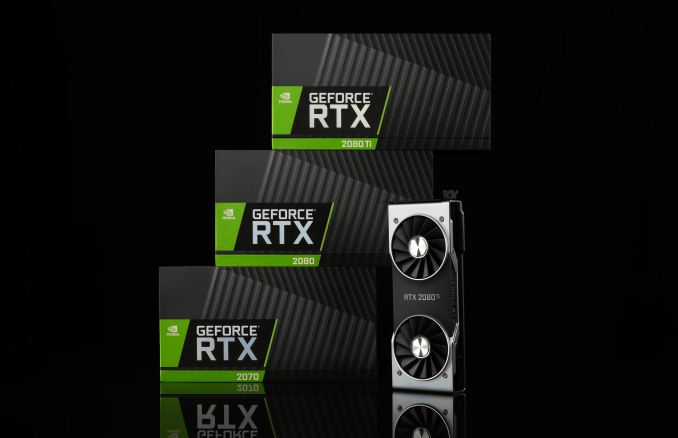
Concluding their Gamescom festivities for their newly-introduced GeForce RTX 20-series, NVIDIA has revealed a bit more about the hardware, its features, and its expected performance this evening. Tonight NVIDIA is announcing the new Ansel RTX features in GeForce Experience, as well as some game performance metrics for the GeForce RTX 2080 up against the GeForce GTX 1080. After recent hands-on demos featuring real-time raytracing, NVIDIA is offering some numbers for out-of-the-box and Deep Learning Super Sampling (DLSS) performance in traditionally rendered games.
| NVIDIA RTX Support for Games As of August 20, 2018 |
||||
| Game | Real-Time Raytracing | Deep Learning Super Sampling (DLSS) | ||
| Ark: Survival Evolved | - | Yes | ||
| Assetto Corsa Competizione | Yes | - | ||
| Atomic Heart | Yes | |||
| Battlefield V | Yes | - | ||
| Control | Yes | - | ||
| Dauntless | - | Yes | ||
| Enlisted | Yes | - | ||
| Final Fantasy XV | - | Yes | ||
| Fractured Lands | - | Yes | ||
| Hitman 2 | - | Yes | ||
| Islands of Nyne | - | Yes | ||
| Justice | Yes | |||
| JX3 | Yes | |||
| MechWarrior 5: Mercenaries | Yes | |||
| Metro Exodus | Yes | - | ||
| PlayerUnknown's Battlegrounds | - | Yes | ||
| ProjectDH | Yes | - | ||
| Remnant: From the Ashes | - | Yes | ||
| Serious Sam 4: Planet Badass | - | Yes | ||
| Shadow of the Tomb Raider | Yes | - | ||
| The Forge Arena | - | Yes | ||
| We Happy Few | - | Yes | ||
Starting with NVIDIA’s DLSS – and real-time raytracing for that matter – we already know of the supported games list. What they are disclosing today are some face-value 4K performance comparisons and results. For DLSS, for now we can only say that it uses tensor core-accelerated neural network inferencing to generate what NVIDIA is saying will be high-quality super sampling-like anti aliasing. Though for further technical information, this is a project NVIDIA has been working on for a while, and they have published some blogs and papers with some more information on some of the processes used. At any rate, the provided metrics are sparse on settings or details, and notably measurements include several games rendered in HDR (though HDR shouldn't have a performance impact).
Otherwise, NVIDIA presented a non-interactive Epic Infiltrator 4K demo that was later displayed on the floor, comparing Temporal Anti Aliasing (TAA) to DLSS, where the latter provided on-average near-identical-or-better image quality but at a lower performance cost. In this case, directly improving framerates. To be perfectly honest, I spent the entire floor time talking with NVIDIA engineers and driver/software developers, so I have no pictures of the floor demo (not that anything less than a direct screenshot will really do it justice). Ultimately, the matter of DLSS is somewhat nuanced and there isn’t much we can add at the moment.
Overall, the idea is that even in traditionally rasterized games without DLSS, the GeForce RTX 2080 brings around 50% higher performance than the GeForce GTX 1080 under 4K HDR 60Hz conditions. Because this excludes real-time raytracing or DLSS, this would be tantamount to ‘out of the box’ performance. Though there were no graphics settings or driver details to go with these disclosed framerates, so I'm not sure I'd suggest reading into these numbers and bar charts one way or another.
Lastly, NVIDIA announced several new features, filters, and supported games for GeForce Experience’s Ansel screenshot feature. Relating to GeForce RTX, one of the features is Ansel RT for supported ray-traced games, where a screenshot can be taken with a very high number of rays, unsuitable for real-time but not an issue for static image rendering.
Ansel RTX also leverages a similar concept to the tensor core accelerated DLSS with ‘AI Up-Res’ super resolution, which also works for games not integrated with Ansel SDK.
In terms of the GeForce RTX performance, this is more-or-less a teaser of things to come. But as always with unreleased hardware, judgement should be reserved until objective measurements and further details. We will have much more to say when the time comes.


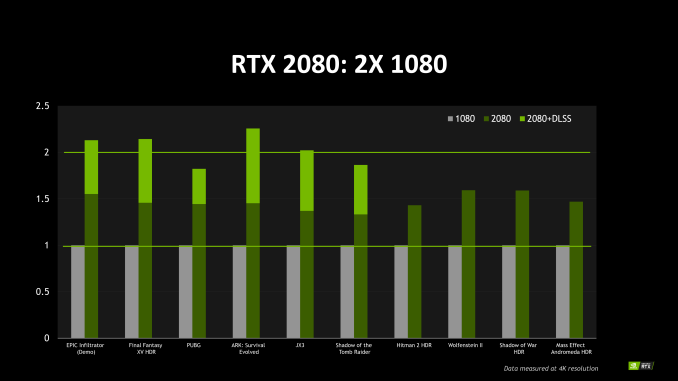
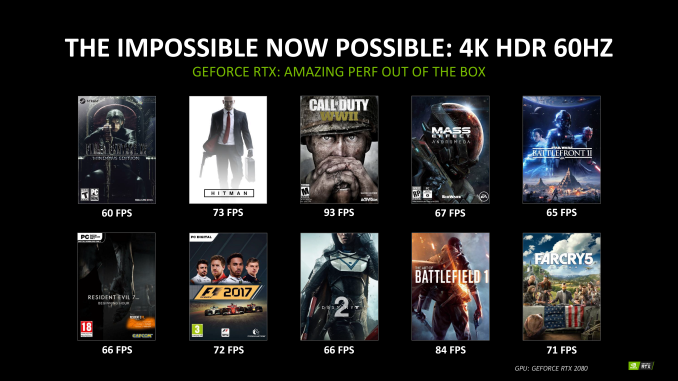
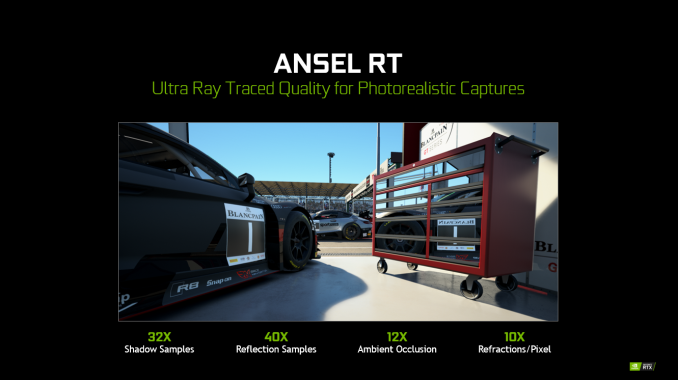
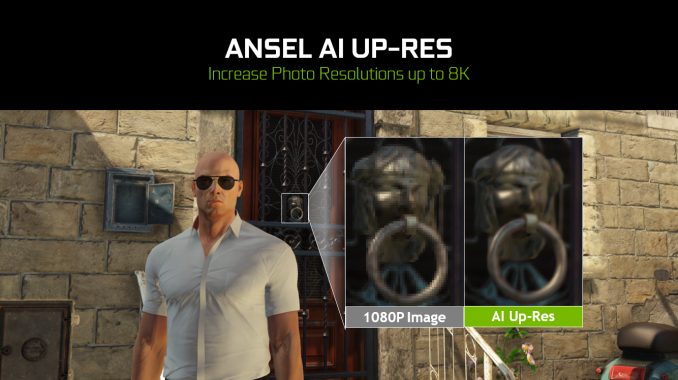








92 Comments
View All Comments
Ryan Smith - Wednesday, August 22, 2018 - link
"Checkerboard" has some specific baggage that doesn't apply here. But yes, the concept is similar: it's a way to get a level of quality similar to rendering at 4K without the actual computational costs of fully rendering at that resolution.maroon1 - Wednesday, August 22, 2018 - link
And thats look like a good technology for people have RTX 2070 and can not run some demanding games at 4KYou will get almost comparable quality of 4K but with performance cost similar to maybe 1800p
jwcalla - Wednesday, August 22, 2018 - link
Now I see why Nvidia hasn't released any product roadmaps in a long while. More and more they're going to have to rely on these buzzword technologies to sell products.wyatterp - Thursday, August 23, 2018 - link
Real time ray-tracing is a buzzword? Ray-tracing as a rendering technique is 3 decades old and is THE gold standard in rendering outside of games.Santoval - Wednesday, August 22, 2018 - link
"NVIDIA presented a non-interactive Epic Infiltrator 4K demo that was later displayed on the floor, comparing Temporal Anti Aliasing (TAA) to DLSS, where the latter provided on-average near-identical-or-better image quality but at a lower performance cost. In this case, directly improving framerates."How can an antialising technique with a "performance cost", whether high or low, improve frame rate? That is contradictory. Judging from the high increase in frame rate in the games that employ it (the graph isn't clear but I suppose that's what it shows), and by how Jensen Huang focused on deep learning's ability to super-sample low res images by "adding missing pixels" in his presenation, DLSS does not appear to be an antialising technique at all.
Rather, it looks like it is a pure super-sampler, just as its acronym says. My guess is that it allows games to be rendered internally at lower resolution (say 1440p, maybe even 1080p), then super-sample them to a 4K-equivalent resolution, and then output them as native 4K, and thus raise frame rate close to that of the lower internal resolution. Huang would not have presented that ability for no reason, and frankly, how else would it provide a performance gain?
An alternative idea might be to off-load game AI and physics to the tensor cores and raise frame rate by freeing the shaders from that task (something that might also be possible, but as a separate technique), but would that lead to so much higher frame rate? And why would that be called "super sampling"?
I don't actually object to the lower resolution super-sampling scenario by the way, providing it beats most blind tests. Super-sampling (or "resolution upscaling", which is the TV set term) has always been a lame technique with little to no benefit, but deep learning might actually make it viable.
eddman - Wednesday, August 22, 2018 - link
"How can an antialising technique with a "performance cost", whether high or low, improve frame rate?"He meant improved performance compared to TAA. That graph should've said "1080+TAA" and "2080+TAA".
maroon1 - Wednesday, August 22, 2018 - link
If RTX 2080 is 40-50% faster than GTX 1080, then that should make it even faster than GTX1080TiWith DLSS enabled, it would blow any pascal GPU out of water (even Titan V)
wyatterp - Thursday, August 23, 2018 - link
I don't think it will always be faster than the 1080TI based on the fact the TI has more memory and still has slightly faster memory throughput. This chart obviously makes a complex comparison difficult. I'm still excited for the 50% increase over the 1080, and more importantly, I'm on board with the move to Ray Tracing. I've yet to buy a high refresh rate monitor precisely because I don't need that assessment spoiling how I view games. I want the best possible IQ with 60FPS if possible. I still play console games which largely cling to 30FPS - so I even accept that somewhat on PC games, even though I really want 60FPS min in most games.ThrakazogZ - Wednesday, August 22, 2018 - link
I'm guessing they may not be getting the amount of pre-orders, for what seems to be an overpriced card, that they hoped for. So they release a graph that shows no useful information, and claim 135% increased performance. The graph shows the 1080 goes to 1, while the 2080 goes all the way to 2.35.......the only thing that really tells us is that the tallest graph bar for the 2080 is 135% longer than the bar for the 1080, given the graphs scale. The best thing to do is wait for 3rd party testing to give us actual performance numbers. Until then, people need to resist the marketing hype, and remember that you should never pre-order something you know nothing about.Batmeat - Wednesday, August 22, 2018 - link
Every Nvidia card release they ALWAYS have numbers to back it up. Something smells with this release of new cards and having no solid number comparisons. I'm holding off a pre-order.